The portrait of Ginevra de’ Benci at the National Gallery of Art, Washington D.C. – also known as The Lichtenstein Lady – is considered the first portrait made by Leonardo da Vinci (1452 – 1519); there is a consensus among critics that he painted it when he was 22 years old.
It is a haunting, gloomy, picture possessing a magnetic spell, similar to that exerted by the Mona Lisa at the Louvre Museum. Once you stare into her sad face, you will never be able to forget her; she remains carved into your subconscious. It is a very small painting on a poplar wood panel (39×37 cm) but the lower part was sawn away for at least 8 inches. We don’t know why and we don’t know when. There is a garland painted in the back with the words Virtutem Format Decorat shows the mutilation. Probably she was keeping her hands close to her chest. There is a sketch of hands made by Leonardo in the Windsor Collection which could fit. But that is just guesswork, like for most of the things related to Leonardo da Vinci. Tradition has that this is a portrait of the seventeen years old Ginevra de’ Benci, daughter of Amerigo de’ Benci, painted on the occasion of her marriage with Luigi di Bernardo di Lapo Niccolini, on 15 January 1474.
Ginevra died in 1520 and in her youth she was seen as a great beauty. But is this really Ginevra de’ Benci’s portrait? We don’t know but most art critics think so, simply because at her back there is a Juniper tree, ginepro in Italian, therefore Ginevra. That is all.

It was bequeathed to the National Gallery by the Ailsa Mellon Bruce Fund. Ailsa Mellon Bruce (1901 – 1969) was the daughter of Andrew W. Mellon (1855 – 1937) a controversial financier who, after amassing a huge fortune during WW1 begun collecting old masters’ paintings. He then became Secretary of the Treasury from 1921 to 1932 and U.S. Ambassador to the United Kingdom from 1932 until 1933.
In 1930 he was quick to seize a golden opportunity offered by Stalin’s stupidity. The Soviet dictator had ordered to the directors of the Hermitage Museum in Leningrad to raise cash by selling art. Mellon took home 21 incredible paintings paying what was for him a pittance: Raphael’s Alba Madonna and Jan Van Eyck’s The Annunciation among them. In 1936 Mellon convinced President Roosevelt to build the National Gallery of Art and donated his collection to the American people, even financing and supervising the construction of the building.
In 1967 his daughter Ailsa Mellon Bruce purchased Leonardo da Vinci’s Ginevra de’ Benci from the Princely House of Lichtenstein, paying five million dollars for it. An hefty sum of money in those days, possibly the equivalent of 300 US millions today, but it was still a bargain. How this portrait got it into Lichtenstein in the first place I have not been able to find but in Lichtenstein they are regretting parting from such masterpiece. Up to the middle of the XIX century this picture was believed to have been painted by Lucas Cranach, Leonardo had used his fingers to smooth the face of Ginevra (if she is really Ginevra) where his fingerprints have been detected.
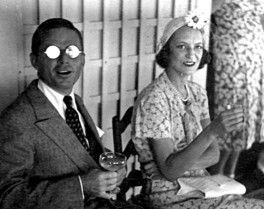
When we look at the supposed portrait of Ginevra de Benci it is hard to believe that she was only seventeen years old and that she was a great beauty. If really this work was delivered by Leonardo on the date of her marriage then he should have begun painting her at least one year earlier, when she was only sixteen years old. But we know for a fact that Leonardo could not be pushed to work fast, not even by kings and princesses. Quite the contrary!
This lady looks like very mature and, furthermore, she seems like going to a funeral, more than going to her marriage. She has no jewels on her neck and carries a funereal black sash on her shoulders.
During the Renaissance when an artist received a commission for a portrait he was not free to deliver something which would not please the sitter, like in our days Francis Bacon’s unflattering portrait of Queen Elisabeth. Vasari and other old biographers mention that he painted, a wonderful portrait of Ginevra de’ Benci but it was then lost, like several other works by Leonardo, perhaps burned in the Bonfire of Vanities organized by Girolamo Savonarola.
We have strong reasons to think that this is certainly not the portrait of Ginevra de’ Benci but rather the portrait of Fioretta Gorini (1453 – 26 April 1478). Fioretta was the mistress of Giuliano de’ Medici, the brother of Lorenzo, who was murdered in 26 April 1478 during the Pazzi conspiracy. Fioretta Gorini was by then pregnant and gave birth, one month after the violent death of her lover, to Giulio de’ Medici, the future’s pope Clement VII. The baby was baptized by Antonio da Sangallo, a close friend of Giuliano and then presented to Lorenzo de’ Medici, who accepted him into the Medici’s household.
At the Bargello Museum in Florence there is a marble bust attributed to Andrea del Verrocchio (1435 – 1488) – Leonardo da Vinci’s teacher – believed to be Fioretta Gorini. She is holding a bunch of flowers close to her chest (fioretti or fiorellini in Italian). We can notice here the same sombre, funereal, expression on the portrait of Ginevra de’ Benci at the National Gallery.
The likeness of this marble bust with Leonardo’s painting is just too great to be missed. It might also be that this marble bust was not sculptured by Verrocchio – its attribution is uncertain, like for most of Verrocchio’s works, with the exception of the the David and the Bartolomeo Colleoni equestrian monument in Venice, finally cast in 1496 by Leopardi
We believe that this marble bust could well be the only sculpture in existence by Leonardo da Vinci. I am not the first to claim it (Hans Mackowsky, William Suida et al.) and I do believe that there are strong supporting arguments.
It is clear to me that Leonardo da Vinci was painting the same woman represented in the marble bust, changing somehow her facial expression but keeping the same silken blouse and the same hairstyle. The slit in the bodice of the painting at the National Gallery had been badly over-painted, this is another indication that originally it was closer to the marble bust.
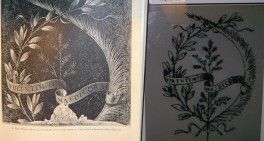
The sketch of the hands at Windsor, mentioned above, are often connected with the missing part of the Ginevra de’ Benci’s painting, but no one had thought the most logical solution to the riddle: that they were a preparatory sketch for the existing hands on Fioretta Gorini’s marble bust kept at the Bargello in Florence. The position of the right hand on the bust and left hand on the sketch seems a match.
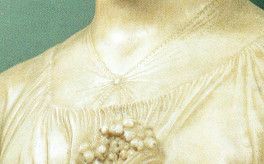
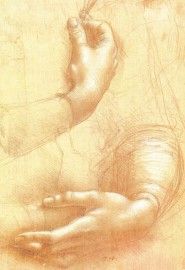

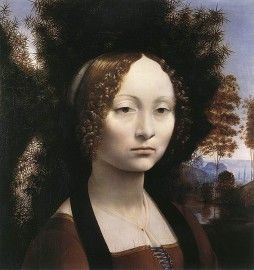
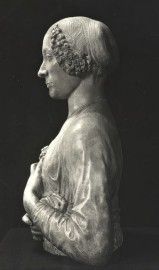
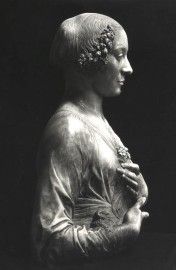
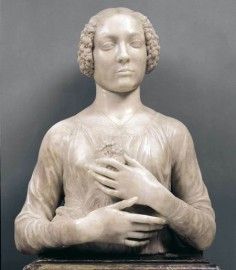
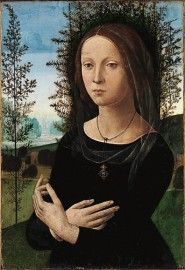
Interesting theory, Angelo. There are specific softwares that can rebuilt a face starting from a skull and so-I think-from a statue. It would be very nice to use them to check your idea. Let’s find the right lab: it could be a great scoop. Ciriaco
Thank you, Ciriaco. I have great news on this painting…I am planning an interview on the SCMP in a couple of weeks, right when my book on Leonardo’s Da Vinci’s Chinese mother will be published. Don’t go away!
Dear Angelo Paratico,
did you find the inspiration for this article by looking at my website: http://www.kleio.org/en/history/famtree/medici/421.html ?
I do not think that it can be a coincidence that I claimed on my website that the depicted is not Ginevra de Benci, but Fioretta Gorini (and I was for some years the only one who did this) and now I read in this article, you do the same. At least at Wikipedia they name me as the original source for this claim. By the way Fioretta Gorini was not the mistress of Giuliano de’ Medici, but his wife. You should learn the symbolism of the Renaissance!!! And the last picture in your article does not show the real Ginevra de’ Benci. Or do you have a written historical source describing this woman in detail and telling us this is Ginevra de’ Benci? The depicted is Chiara Sforza. A juniper tree never points to a woman named Ginevra in the Renaissance. This was an invention of an art historian in the 20th century.
Regards, Maike Vogt-Lüerssen
Dear Maike Vogt-Lüerssen
Thank you for your comments.
I took inspiration from Frank Zollner ‘Leonardo da Vinci’ Taschen, 2011 p.219. but I think this theory is around since long before, as I quoted up here, Hans Mackowsky and William Suida, for what matter. Since I posted this article I have come to the conclusion that I was wrong.
Do you have a proof that Giuliano de’ Medici was the husband of Fioretta Gorini? There is no record of it in standard biographies on the House of Medici. And there is not proof, as for most of the things that concern Leonardo, that the lady in the picture is indeed Ginevra de’ Benci, just common opinion among the learned but probably she was not. Chiara Sforza? Could well be…
Thanks
A. Paratico
Dear Angelo,
Today I’ve seen a bust of Beatrice D’Este in travertine marble (Michelangelo), with the same hairstyle and the same tiara of Beatrice in the portrait by Leonardo.
A high quality sculpture executed in high quality material and close to lifesize.
For more information, you can contact to Diego Devoto =)
Have a nice weekend!
Daniel.